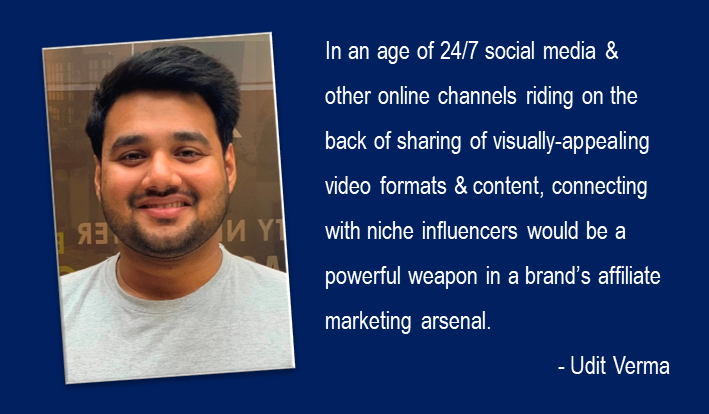There is no doubt that Covid-19 has brought forth challenges and opportunities alike for businesses. Even as the pandemic waxes and wanes through various phases and as we enter the second year since the outbreak, marketing budgets have usually been the first to face cutbacks. However, what is reassuring is that digital marketing spends have been given an upward push by most businesses. So amidst all this ebb and flow, working out partner marketing with a particular focus on affiliate marketing can be one potent way for brands and advertisers to navigate through these times of uncertainty. Here are some of the steps and ways in which a company can build an effective and viable partner or affiliate marketing programme this year.
Choose the right affiliate programme/partner
Needless to say, the first step for a brand is to find the right partner or choose an affiliate programme apt for its business. Before taking the plunge, the brand must be able to thoroughly weigh the suitability of a partner or platform. So, the nature of the affiliate’s audience, the audience’s preferences and inclinations, engagement rates, site rankings and general brand equity must guide the picking of an affiliate partner. This selection must also align with the broader and tangible goals set by the brand. In the end, the aim should be to choose a credible and trustworthy partner engaging with whom would raise the collective brand equity for both the parties, namely, the brand and the affiliate partner.
Negotiate clear terms of agreement & payout models
Without doubt, the terms of agreement between a brand or advertiser and the intended affiliate partner must be set out with utmost clarity and transparency. Every specific goal must be linked with specific KPIs which could help the brand track the performance of a campaign on the affiliate platform. These goals could range from vanity metrics such as traffic, impressions and clicks to actionable metrics such as leads or actual sales. Commission rates could be set differently whether on a pay-per-click, or pay-per-lead, or pay-per-sale basis. In other words, for the brand, cost-per-click, cost-per-lead and cost-per-sale must be thought through beforehand along with indicative conversion rates and Return on ad spend (RoAS). In addition, attribution windows or the time period within which an affiliate gets credit and therefore commission for a certain action, needs to be spelled out in advance. The terms of agreement could also account for potential cross-selling & upselling activities.
Incorporate deals and offers to convert leads into sales
While executing affiliate marketing strategies, a brand should also consider employing concessional coupons, vouchers, discounts and deals in order to turn vanity figures such as clicks, form-filling and registration into actual downloads and sales. This particularly applies to product or service brands which operate in a highly competitive consumer market where both price differential and the availability of a wide range of options are already driving customer activity and choices.
Go for influencer marketing
In an age of 24/7 social media and other online channels riding on the back of sharing of visually-appealing video formats and content, connecting with niche influencers would be a powerful weapon in a brand’s affiliate marketing arsenal. With a readily-available audience, not only do these influencers possess the ability to amplify a brand’s presence and reach exponentially and in very little time, joining hands with them also saves enormously on the marketing budget. This is due to the prohibitive costs involved in taking the customary celebrity endorsement route. The explosion in numbers of micro and nano influencers has completely changed the game in recent years. Remember, social media is increasingly turning into all-purpose commercial media.
Prepare top-class content
Even as brands opt for affiliate marketing, for their own part, they must prepare top-quality content differentiating them from competitors, backed by an impactful content strategy. Besides the campaign content and its relatability with the intended audience, the landing or product page must be optimized sufficiently for the affiliate partner to drive traffic and enable conversions.
Identify top affiliates and better-performing affiliate programmes
Brands must also keep a track of affiliates which trigger more call to action (CTA) on the basis of their campaigns and offerings as also those which are responsible for converting increased number of clicks and leads into actual sales and thereby generating increased revenues for them. Also, affiliates which have proved to be loyal and delivered maximum customer lifetime value (CLV) to the brand must be identified. As such, a greater proportion of the brand’s marketing/advertising spend should be directed towards these affiliates. Similarly, better-performing affiliate programs must be paid greater heed to.
Build own affiliate network
At the same time, brands must also pick out affiliates which bring onboard more affiliates or sub-affiliates through referrals while also being mindful of the diversity and relevance of audiences and programmes. In fact, once a brand has settled into different relations and partnerships with several affiliate partners, it could consider developing its own affiliate network predicated on broadly common and mutually beneficial business goals.
Explore co-branding engagements too
While embarking on the path to full-fledged affiliate marketing, brands and advertisers should also explore co-branding engagements and ventures. From conducting research and creating and branding content together to employing guest blogging and e-mail swaps, to tapping into social media capital of one another, to co-hosting of live events, speaking events, webinars and contests, there is an assortment of activities that a brand could also consider while pursuing affiliate and partner marketing. Such co-branding pursuits would give an additional impetus to a brand’s affiliate and partner marketing programme.
Therefore, there are a wide array of options that a brand can exercise while contemplating affiliate and partner marketing programmes.
The views and opinions published here belong to the author and do not necessarily reflect the views and opinions of the publisher.



Be the first to comment on "Tips to build a profitable partner marketing programme in 2021"